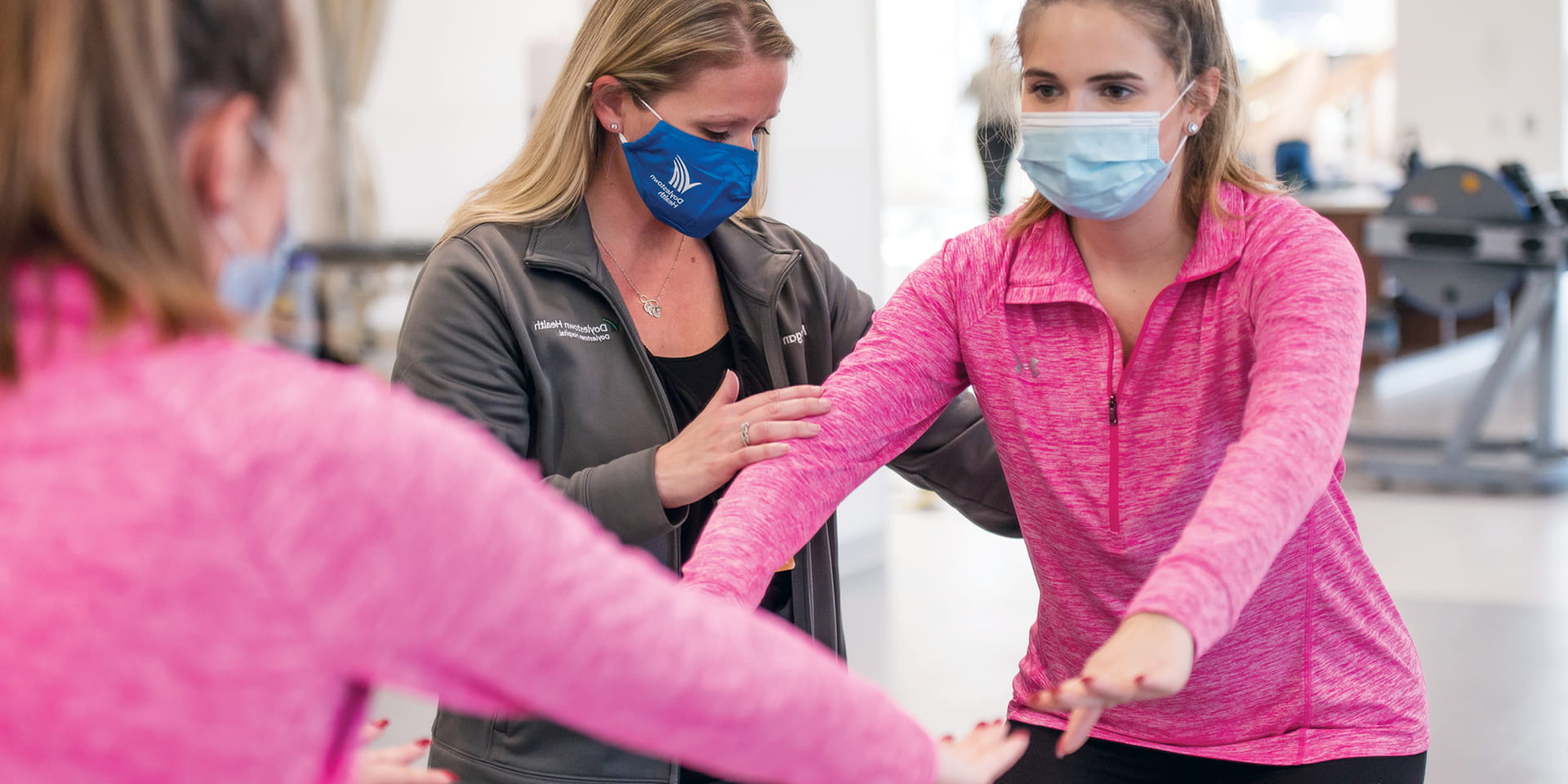Pelvic floor dysfunction is a common condition. However, because the symptoms can be uncomfortable to discuss, many people do not ask questions and never discover that effective solutions exist. As a result, too many suffer in silence — unnecessarily.
We spoke to Jenna Boyes, PT, DPT, Doylestown Health outpatient clinical lead pelvic floor specialist, about pelvic floor dysfunction, including its symptoms, causes and treatments.
What is the Pelvic Floor?
Jenna describes the pelvic floor as “a crucial group of muscles that no one knows about.” This complex muscle structure suspends between the pelvic bone in the front and the tailbone in the back, forming a sling, or hammock. These muscles, nerves, connective tissues and skeletal structures support the bladder, rectum, uterus and vagina (in women) and prostate (in men).
In the simplest terms, “when you are sitting on a chair, you are sitting on your pelvic floor,” describes Jenna.
Having a strong pelvic floor is essential for proper control and elimination of bladder and bowel function. Jenna explains that these three layers of muscles “help with pelvic stability while we move, run, walk, climb stairs, bend and lift. It assists in moving fluid systems through our body to help with healing and to help regulate appropriate bowel and bladder function.” This important muscle system is also vital in sexual performance and comfort.
Symptoms of Pelvic Floor Dysfunction
Men and women have the same pelvic muscle structure, with different genitalia. While men and women share many of the same symptoms of pelvic floor disorders, some symptoms are sex-specific.
Men and women with pelvic floor disorders may experience:
- Stress incontinence: Losing urine during physical movement, such as sneezing, laughing, lifting, jumping, running, etc.
- Urinary urge incontinence: The sudden, intense urge to urinate. Jenna explains that some people diagnosed with overactive bladder (OAB) would benefit from pelvic floor therapy.
- Bowel dysfunction: Includes losing stool (fecal incontinence) or constipation, pain, or pressure in the rectum
- Interstitial Cystitis: Also called painful bladder syndrome, patients often think they have a urinary tract infection, but repeated testing shows no sign of infection. Symptoms include urinary urgency, pain, frequency, pelvic pain and pressure.
- Back, groin, or rectal pain
- Hernia
Women-specific symptoms
- Endometriosis: muscles that form the pelvic floor can tighten in response to the severe pain caused by inflammation of the endometrial tissue.
- During pregnancy and post-partum: Pelvic floor therapy is an excellent place to start for new moms looking to strengthen and restore proper, pre-pregnancy muscle function.
- Pain during intercourse: This may be related to muscle restriction that can be relieved through stretching and strengthening exercises.
Men-specific symptoms
- Pre and post prostate cancer surgery: Therapy helps men find their pelvic floor to prepare muscles before surgery. After surgery, therapy helps men with stress and/or urinary urge incontinence.
Jenna emphasizes that while symptoms of pelvic floor dysfunction are common, “it is not normal function and people should never just put up with it.” Treatment is effective in reducing pain, increasing function and adding confidence.
Who Benefits from Pelvic Floor Physical Therapy?
Anyone can benefit from this therapy. Age is not a barrier—people in their teens through their nineties can benefit from pelvic muscle coordination and strength.
According to Jenna, men incorrectly think that this treatment is only for women. Women who have never had children falsely believe that they are not a candidate, when actually they can significantly improve muscle strength and control. Women who have had a baby falsely believe that “the damage is done,” when, in fact, women who do pelvic floor muscle exercises have been shown to be five times more likely to improve pelvic floor muscle function and be relieved of their symptoms. 1
What Can a Patient Expect During Pelvic Floor Physical Therapy?
Patients must first be cleared medically and have a prescription for this treatment from their doctor. Patients are typically seen once or twice per week; however, Jenna stresses that the therapists will work with the patient’s schedule and that scheduling should never be a reason to not seek care.
Providing a safe environment where an individual feels comfortable is of utmost importance at every stage of treatment. For example, an internal evaluation in a private treatment room by a physical therapist that specializes in orthopedics and pelvic health may be part of the initial evaluation process. If a patient is uncomfortable with this particular assessment, there are other options available. An internal evaluation is not required for a patient to benefit from pelvic floor physical therapy.
Education is a big part of the program as well, according to Jenna. Therapists use anatomy models to teach patients about muscle systems that many patients never knew were there. Patients also have access to the beautiful new gym equipment available at the recently opened Clark Outpatient Rehabilitation Center. Jenna advises that it takes six to eight weeks to build strength in the muscles and approximately 12 weeks to assess if treatment yields results. Most patients who keep up with the home program as outlined during therapy will retain the benefits.
Ongoing pelvic floor health, including reduced pain and increased control, requires a “lifestyle change,” stresses Jenna.
Scheduling and Questions
To schedule an appointment call 215.345.2274, select option 4.
For questions about our programs and services, call 215.345.2894.
- Pelvic floor muscle training versus no treatment, or inactive control treatments, for urinary incontinence in women, 04 October 2018, Chantale Dumoulin, Licia P Cacciari, E Jean C Hay‐Smith
About Clark Outpatient Rehabilitation Center
Located in the Ambulatory Center on the campus of Doylestown Hospital, Doylestown Health's spacious new Clark Outpatient Rehabilitation Center provides a convenient one-stop option for multidisciplinary outpatient therapy. Seamlessly connecting consultation, diagnosis, intervention and treatment services with physical therapy, occupational, hand and speech therapy, the Clark Outpatient Rehabilitation Center is staffed by licensed therapists only.


